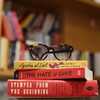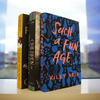[ad_1]

A collage of the books featured in the episode: Catherine House; Take a Hint, Dani Brown; Real Men Knit; and Mexican Gothic.
LA Johnson/NPR
hide caption
toggle caption
LA Johnson/NPR

A collage of the books featured in the episode: Catherine House; Take a Hint, Dani Brown; Real Men Knit; and Mexican Gothic.
LA Johnson/NPR
The Code Switch team has been mired in a months-long debate that we’re attempting to settle once and for all: What kind of books are best to read during this pandemic? Books that connect you to our current reality? Or ones that help you escape it?
We’ve heard a lot of people talking about reading everything they can about plagues and pandemics: histories of the Spanish flu, yellow fever, the bubonic plague. And of course, people are also scooping up books as fast as they can about racism, antiracism and white fragility, trying to contextualize this “moment.”
On the other hand, there are just as many people who are staying as far from all of that as possible. Instead, they’re sinking into the soothing comfort of books that take place in happier times and places, and have happy beginnings, happy middles and (most importantly) happy endings.
But in the midst of this debate, we spoke to someone who convinced us that maybe escapism versus reality is a false choice. Farah Jasmine Griffin is a professor who teaches African American literature at Columbia University. She said that for so much of Black literature, it’s a “both, and” situation. In her classes, the reading lists are full of books by Black authors who refuse to ignore the harshness of the world around them — but don’t ignore the beauty. People like Gwendolyn Brooks, Octavia Butler, James Baldwin and Zora Neale Hurston.
“In my class, we don’t get away from the problems, but we do find that it’s the space of the community that we’re building together that helps alleviate the stress,” Griffin says. “None of these texts provide escapist readings, although some of them in their sheer beauty and the beauty of the language, you know, gives us a moment to remember that there’s something in life that’s also quite beautiful.”
We spoke to Farah about the authors that stay relevant, who she’s teaching right now and the special pandemic-assignment that’s inspiring her students. This interview has been edited and condensed for clarity.
At the end of last semester, you gave the students in your Intro to African American Literature class a creative writing assignment (which you later wrote about for The Boston Review.) Tell us about that assignment and what inspired you to come up with it?
You know, we suddenly had to get off of campus in March and students were evicted, for lack of a better word. We were all kind of thrown up in the air. So I thought that we needed to just stop and slow down. And I said, you know, I’m not lecturing in front of them about a book a week anymore. We’re all in this critical moment. And I decided on a creative project. Some of them chose to do creative writing, but I left it open to them what they thought would count as a creative project. There was the influence of Toni Morrison on my thinking, and the way that she often talked about developing the capacity of our imaginations being as important as our critical thinking. So I thought, this is a time for us to sit back and reflect, and not only think about how to take a book apart, but how to imagine something, how to create something out of whole cloth, out of new. How to create something in the moment of crisis.
You also gave your students respond to a list of questions, tell us about those?
Certainly. So, in addition to asking them to do a creative project, I asked them to respond to a series of questions. And we did this as a kind of conversation, but I gave them prompts. Those prompts were inspired by Arundhati Roy’s essay, where she talks about the period of the pandemic being like a portal. We’re going through a portal, and there are ways that we can determine how we want to emerge on the other side. So inspired by Roy, I ask them: What kinds of things about their life pre-pandemic would they like to leave behind? What kinds of things have they discovered? What kinds of things do they value more? And what kind of world would they like to see on the other side? And how are they prepared to commit to building that other world on the other side?
Those were prompts. And I told them that no one was going to check their grammar — that we just were going to do this together, and we needed to hear what each other had to say. And they were so thoughtful about those prompts. And I think, you know, feeling like they weren’t going to be graded for them actually freed them and they shared beautiful thoughts and ideas.
What has really stuck with you from reading all of what they wrote? What’s something that really moved you when you read it?
These are young people who are very high achievers — that’s why they’re at Columbia. And I think that they all became aware of how busy and full their lives were. Not full in a good way, but just busy trying to achieve. That stopped them from making the kinds of human connections that were important to them. And what they realized is that what they really missed was being in each other’s company. They wanted to just slow down this sort of rat race of achievement, which they are experiencing at 18, 19, 20 years old, and really connect with other people. That just really made me think what are we doing to our young people that at 19, they almost are burned out from being hyper-achievers?
This is when we were first becoming aware of the kind of disparities, the racial disparities in those people who were most vulnerable to this, or the class disparities, or the need of a certain group of people to have to work and need income and not be able to work virtually in the way that we were in class. And for some of them, we’ve been reading about these kinds of things all semester, you know, in the most beautiful and brilliant literature. But this just made a lot of that inequity real to them. So what moved me was the ways that they wanted to commit to not just giving lip service to working against climate change or racial injustice, but to really doing something, joining an organization, or founding organizations, or being involved in a reading group or teaching each other. It was nice to watch a kind of awareness flower, and then a commitment in terms of what they wanted to do. And because they’re young, it was so hopeful, because they really believe they can change the world.
When you did this assignment, what were the types of things these students were turning into you as their creative project? The things that weren’t written?
Oh, my goodness. They just blew me away. I had like three or four students who turned in musical things. They either did compositions where they actually composed music inspired by some of the books that we’d read, either in the lyrics of the music or even in the form of the music. We read Octavia Butler, and one of the themes in Octavia Butler’s Parable of the Sower is change. So one of the assignments sang the word “change.” And every time they did it, they did it over a chord change or a chord progression. It’s just amazing.
I also had students who drew sketches or paintings. One woman drew the pear tree from Zora Neale Hurston’s Their Eyes Were Watching God. There’s a famous moment with a pear tree. And she painted that, this beautiful pear tree, on her wall at home in the room that she was stuck in during quarantine. Another really talented young poet decided to make a poem in response to Hurston, but she read it over an experimental film that she made. I mean, they were so far above and beyond anything I imagined when I gave them that assignment.
I was wondering if you could put into context, the theme of change, for people who haven’t read Parable of the Sower.
Octavia Butler was not originally on the syllabus this year. I’ve taught her before, but she was not on the syllabus. And when we were forced to go home, I pulled off a lot of text and I put her on there and I said, let’s spend two weeks reading her, because she’s writing about all kinds of catastrophes. And we were in the middle of a catastrophe.
Butler is writing about political catastrophe, economic catastrophe, environmental catastrophe. And the protagonist of that story is a young woman, so I thought my students might identify with her youth. And she’s creating a religion, basically, and a religion that addresses questions about the moment that she’s in. And the only constant in her life and in that moment is change. So that becomes the central religious and philosophical principle: to be ready for change, which means we have to be improvisatory. So that’s the constant in the religion that she comes up with — that God is change. And it provided for some fascinating, reflective discussions, both about the novel, as insightful as any that I’ve read from a literary critic, and also about our moment.
I’m assuming that your reading list probably always speaks to the moment that we’re in. What other books on that reading list do you think are just right in line with what we’re going through right now and may help people reflect or process this very surreal and scary and unprecedented time that we’re in?
I always tell my students at the beginning of the Intro to African-American literature course, for better or for worse, I can guarantee you that something will happen during the moment that we’re reading these books where these books will remain relevant. There’s always something. But I never anticipated this particular something.
We read the short stories of Richard Wright, Uncle Tom’s Children, and those short stories matter because they show natural disasters, like a flood, and how a flood impacts the Black people of the story differently than it does the moneyed whites. We read James Baldwin. We read If Beale Street Could Talk, about a young man who was wrongfully convicted of a crime that he did not commit, or just a kind of encounter with a police officer. What I love about Baldwin is he always provides an alternative in the same text. So he’ll have, you know, the kind of police officer who we would expect a young Black man to encounter. But then he has a community of people who support and protect a young black couple in love that include an immigrant store owner or a man who rents him an apartment, a Jewish landlord or a Spanish speaking restaurant owner.
Any syllabus of African American literature? I think because race is so at the core of so much in the United States that those books, the best of them, speak to the moment that we’re in.
[ad_2]


